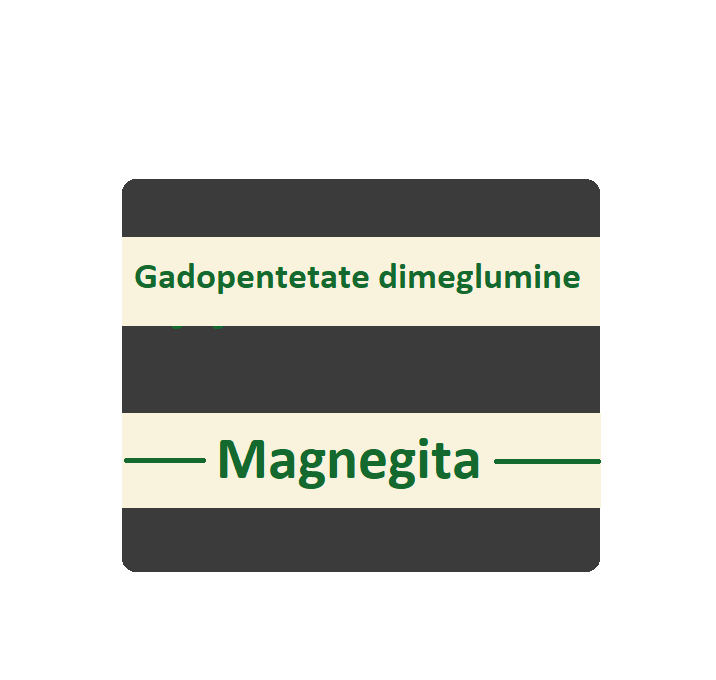Gadopentetate dimeglumine (Magnegita, Magnevist) is a radiocontrast agent that is used during MR imaging diagnostic procedures to visualize vascular lesions of the brain, spine, and other body parts.
Gadopentetate dimeglumine Uses:
-
Body imaging:
- MRI agent to visualize body lesions with abnormal vascularity in adults and children of 2 or more than years of age.
-
CNS imaging:
- MRI agent to visualize CNS lesions with abnormal vascularity in the spine,brain, and associated tissues in adults and children of 2 years or more than 2 years of age.
-
Head and neck imaging:
- MRI agent to visualize head and neck lesions with abnormal vascularity in adults and children within age of 2 years or more than 2 years of age.
-
Off Label Use of Gadopentetate in Adults:
- Magnetic resonance angiography (MRA)
Gadopentetate dimeglumine (Magnegita, Magnevist) dose in Adults
Gadopentetate dimeglumine (Magnegita, Magnevist) dose in the Body, CNS, head, and neck imaging:
- IV: 0.1 mmol per kg (0.2 mL per kg)
Note: Dosing for patients more than 130 kg (286 pounds) has not been studied.
Gadopentetate dimeglumine (Magnegita, Magnevist) dose in Childrens
Note: Dosing presented in mL per kg and mmol per kg; use caution. Parenteral solution contains 0.5 mmol per mL of gadopentetate dimeglumine.
Gadopentetate dimeglumine Dose in the Body, CNS, head, and neck magnetic resonance imaging:
-
Children ≥2 years and Adolescents:
- IV: 0.2 mL per kg (0.1 mmol per kg);
- The imaging must be completed within 1 hour of injection.
Note: Dosing for patients more than 130 kg (286 pounds) has not been studied.
Pregnancy Category: C
- Gadopentetate dimeglumine crosses over the placenta
- Contrast agents containing gadolinium-based elements in pregnancy should not be used.
- Additionally, it is important to only consider using a contrast agent if the information required from an MRI study can't be obtained without using one. This cannot be delayed until after delivery.
- If it is proven to significantly improve diagnostic performance, and is expected that it will improve fetal or maternal outcomes, a gadolinium-based contrast agents with MRI might be considered for pregnancy.
- Agents that pose a low risk of developing nephrogenic fibrosis are recommended to be administered at the lowest possible dose.
Gadopentetate dimeglumine use during breastfeeding:
- Breast milk contains gadopentetate dimeglumine.
- Subjects had different maximum milk concentrations and times of maximum milk concentrates.
- However, gadolinium concentrations varied over time and increased with maternal dose and volume of milk produced.
- Breastfeeding may continue after discontinuation due to the low expected excretion of breast milk and low absorption by infants' GI tract.
- They can store and pump milk before the procedure, then bottle-feed the milk stored during that time.
- Theoretically speaking, milk's taste could be affected if it contains contrast media.
- Women who choose to temporarily stop breastfeeding can express breast milk or discard it from one breast for 12-24 hours after administration of contrast media.
- According to the manufacturer breastfeeding during therapy is a decision that should be made after considering the risks to infants and the benefits to mothers.
Gadopentetate dimeglumine (Magnegita) Dose in Kidney Disease:
-
GFR >30 mL/minute/1.73 m²:
- The manufacturer's labeling doesn't provide any dosage adjustments; use with caution. The risk for NSF development increases as renal function decreases.
-
GFR <30 mL/minute/1.73 m²:
- Its use contraindicated.
-
Hemodialysis:
- If administered to patients already receiving hemodialysis, consider prompt hemodialysis following exposure (eg, within 3 hours).
- Data has been shown hemodialysis enhances gadolinium elimination with average gadolinium excretory rates of 78 percent, 96 percent, and 99 percent in the first, second, and third hemodialysis sessions, respectively.
-
Peritoneal dialysis:
- Likely to be less efficient at clearing gadolinium.
Dose in Liver disease:
The manufacturer’s labeling doesn't provide any dosage adjustments; does not undergo significant hepatic metabolism.
Side Effects of Gadopentetate dimeglumine:
-
Central nervous system:
- Headache
- Sensation of cold
- Dizziness
-
Gastrointestinal:
- Nausea
Contraindications to Gadopentetate dimeglumine:
- Chronic severe kidney disease (GFR lower than 30 mL/minute per 1.73m2)
- Acute kidney injury
- Hypersensitivity to gadopentetate or any component of this formulation.
- Canadian labeling: Additional contraindications not in US labeling
- Due to their immature renal function, neonates can live up to 4 weeks.
Warnings and precautions
-
Extravasation:
- Monitor infusion site.
- Avoid extravasation.
- Vesicant: Before and during administration, ensure that the needle/catheter/line is correctly placed.
- There have been rare cases of skin and soft tissue necrosis as well as thrombosis and fasciitis at the injection site.
- Sometimes, phlebitis or thrombophlebitis can be seen within 24 hours. Supportive treatment is available.
-
Gadolinium retention:
- Gadolinium can be retained in bone, skin, liver, spleen and kidneys for many months to years.
- The bone has the highest concentration and longest retention time.
- Linear GBCAs (gadodiamide and gadoversetamide > gadoxetate disodium, gadopentetate dimeglumine, and gadobenate dimeglumine) result in more retention than macrocyclic GBCAs ( gadobutrol,gadoterate meglumine, and gadoteridol).
- Patients with normal renal function may be more at risk of gadolinium retention.
- These include patients who require multiple lifetime doses, pregnant or pediatric patients, as well as patients with inflammatory conditions.
- Patients with impaired renal function have had to deal with the clinical and pathologic consequences of gadolinium storage in their skin and other organs.
- Rarely, however, have they experienced skin problems that were not related to renal impairment.
- Gadolinium retention in the brain and in patients with normal renal function has not been shown to have any adverse effects.
- Minimize repetitive GBCA imaging studies.
-
Hypersensitivity reactions
- Sometimes, delayed reactions can occur within hours after administration.
- Hypersensitivity, including anaphylactic reactions (rare), may occur; appropriate equipment (eg, ventilator) and emergency medications (eg, epinephrine) should be available during use.
- Patients who have had bronchial asthma or allergic reactions in the past may be at higher risk of developing hypersensitivity reactions. Be careful.
-
Nephrogenic systemic Fibrosis: [US Boxed Warn]
- Patients with renal impairment may be at greater risk from gadolinium-based contrast agents.
- Avoid using GBCA enhanced imaging unless it is absolutely necessary for diagnostic purposes.
- Patients with severe, acute renal disease or acute kidney injury (GFR 30mL/minute/1.73m2) are not recommended to use this medication.
- Patients with moderate or chronic kidney disease have a lower risk (GFR 30 to 60 mL/minute/1.73m2), and patients with mild chronic renal disease have a much lower risk (GFR 60-89 mL/minute/1.73m2).
- NSF is a potentially fatal condition that affects skin, muscles, and internal organs.
- Before administering medication, all patients should be tested for kidney dysfunction.
- Consider prompt hemodialysis for patients on hemodialysis.
- Patients at high risk for NSF should not exceed the recommended dose and allow enough time (ie several half-lives), for elimination before re-administration.
- Avoidance of readministration is preferable.
-
Renal impairment
- Patients with renal impairment have experienced a dose-dependent worsening or acute renal failure, usually within 48 hours of administration.
- Before using, evaluate the renal function of patients with kidney impairment; consider following-up monitoring.
- Patients with severe kidney impairment should be cautious.
- Contraindicated for patients with acute kidney injury and chronic, severe renal impairment (GFR 30mL/minute/1.73m2).
Monitoring parameters:
- Patient and injection site should be monitored for signs of hypersensitivity for several hours following injection;
- monitor injection site for extravasation;
- renal function (prior to administration);
- short- and long-term monitoring of signs and symptoms of NSF (eg, hardening and/or tightening of skin, joint stiffness,burning, itching, swelling, deep hip or rib bone)
How to administer Gadopentetate dimeglumine?
IV:
- The dose should be administered at a rate not to exceed 10 mL per 15 seconds.
- Complete imaging procedure within 1 hour of injection. Following administration, flush line with NS 5 mL.
- Vesicant; ensure proper needle or catheter placement prior to and during infusion; avoid extravasation.
Extravasation management:
- If extravasation occurs, stop infusion immediately and disconnect; remove needle/cannula; elevate extremity.
- Aspiration of extravasated contrast media is not recommended.
- Information conflicts regarding the use of hyaluronidase; the American College of Radiology (ACR) Manual on Contrast Media does not recommend hyaluronidase in the management of contrast media extravasation; other sources suggest its utility in extravasation management.
If using hyaluronidase: Intradermal or SubQ:
- Inject a total of 1 to 1.7 mL (15 units/mL) as five separate 0.2 to 0.3 mL injections (using a 25-gauge needle) into the area of extravasation at the leading edge in a clockwise manner or injection of a total of 5 mL (150 units per mL) as five separate 1 mL injections around the extravasation site has been also used successfully.
Mechanism of action of Gadopentetate dimeglumine (Magnegita) :
- An external magnetic field can induce a strong local magnetic field in gadopentetate-exposed tissues.
- The local magnetism causes water protons to be disrupted in the area, which results in a change of proton density and spin characteristics that can be detected using the imaging device.
Distribution:
- It doses not cross intact blood-brain barrier; distribution half-life: 0.2 ± 0.13 hours
Half-life elimination:
- 1.6 ± 0.13 hours
- CrCl ≥60 mL/minute: 2.6 ± 1.2 hours
- CrCl 30 to <60 mL/minute: 4.2 ± 2 hours
- CrCl <30 mL/minute: 10.8 ± 6.9 hours
Excretion:
- Urine (~91 percent as gadopentetate within 24 hours)
International Brand Names of Gadopentetate dimeglumine:
- Magnetolux
- Magnevistan
- Magnilek
- Megaray
- Tomovist
- Viewgam
- Magnevist
- Gadomin
- Magnegita
- Magnetol
Gadopentetate dimeglumine Brand Names in Pakistan:
- Magnevista

 Injection for familial chylomicronemia syndrome.jpeg)


